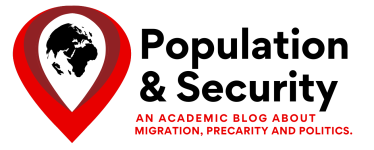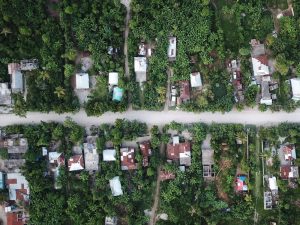During the Covid-19 pandemic, digital technologies were widely applied to enforce public health mandates over the world. From vaccine passport in Canada to mass testing and health code in China, the new technologies dramatically enhanced state power and the effectiveness of public health measures. However, those measures have stimulated resistance and protests, as well as ethical debates on the trade off between public health and civil liberties. Even now that the pandemic is receding, the long-lasting effects of technologies have the potential to change how governments respond to crises. How has the modern state utilized digital technology during the COVID-19? Under what circumstances should we welcome or worry about its continuing use after the pandemic?
Leviathan and the state of siege
Borders are one the fundamental markers of state sovereignty. The state demarcates territorial boundaries to separate inside and outside, and establishes checkpoints and visa regimes to impose control over transnational movements. In most cases, state border implies internal security and external dangers, and in times of crisis, such as wars or plagues, border control can be strengthened and a state of siege declared.
Thomas Hobbes’ Leviathan, one of the most influential works in political theory, provides us with an interesting entry point into the discussion on state powers. On the cover page of the Leviathan (see above), a city is under siege and all citizens have disappeared except for two plague doctors and a giant sovereign watching over the city. The image symbolizes that the state is under a health threat –i.e. a plague- and that it must close its borders to protect its citizens. By doing so, it paints pandemics in a similar light as a war, where the city is under sieged and the sovereign has to keep the enemies –i.e., the virus carriers— at bay.
Many political leaders did compare the Covid crisis to a war. To a degree, the pandemic was similar to a civil war, or guerilla warfare, in which the enemy is mobile and able to penetrate state borders, and transmittable, turning ordinary citizens into a contagious threat. Borders then had to be internalized to contain the transmission of the disease. They also had to be multiplied, with the imposition of national, provincial, municipal, residential and individual borders. Even psychological borders became necessary in order to make people suspect everyone else as a potential health threat. Thus, a plague is in a sort a war of all against all. It is perhaps not surprising then that many countries applied militarized responses to their fight against Covid-19, including military enforcement of lockdown and military-running civilian services. While these military interventions were often harmful to citizenship rights and community trust, this war rhetoric was able to mobilize social resources and public faith, justify the sacrifice of individual liberties and the exceptional control measures.
Digital technologies and new dynamics of borders
At the height of the Covid-19 pandemic, the emerging practices of social and border control were amplified via the application of digital technologies. The Chinese authoritarian state, known for is zero-Covid policy and corresponding hard-core lockdown, certainly capitalized on them. Chinese local authorities regularly implemented mass testing for all residents, requiring them to scan their Health Code at the entrance of all buildings, including their residential communities. A Health Code is a QR code displayed by smartphone applications. It has three colors: green, yellow and red. A green code means that a person is not infected with Covid and can enter facilities. A yellow code means that a person’s health status is undetermined. A red code means that they are infected and have to be quarantined. The key here is that the yellow code is the default status for everyone; during lockdown, they have to do a PCR test every day to prove that they are healthy in order to get a green code. If we compare this to the immigration regime, the health code is the passport and the green code is the visa. People need a visa to go to places while the visa is only valid for one day. It means that with a Health Code, the inland passport regime is totalized, reaching every capillary of society.
Another digital technology used in China to enforce the zero-covid policy was the tracking app. Chinese provincial authorities issued a Itinerary Code for citizens to track their locations via information provided by their telecom operators. During the pandemic, the country was divided into high-risk, middle-risk and low-risk areas, depending on the number of covid cases. If a person travelled to or passed by a high-risk area, their Itinerary Code will be marked as “risky”. They might be refused entry into a public train station or a hotel because of this. These measures aimed to curtail inter-city mobility and establish individual risk records. Local authorities could also, out of precautions, increase the level of alert of a given region to stop some or all people from coming in. This shows that the internal borders and passport controls are not just totalized but also individualized and dynamized. Individual movements within China became constrained by the ever-changing public health conditions and unpredictable local political decisions.
But internalized borders and digitalized health passports are not only practiced in authoritarian states like China, they are also became widespread in democratic states. For example, Canada issued a nation-wide vaccine mandate and required all citizens to have their vaccine passport in order to enter public facilities and travel domestically. While its use of digital technologies for public health security was less extreme and pernicious than in China, it still incurred substantial civil backlashes, such as anti-vaccine movements. No matter the regime type, digital technologies have unprecedentedly affected the delicate balance between public health security and individual liberties.
Future implications
Although the worst of the Covid crisis seems behind us, the implications of digitalized Leviathan are long-lasting. China’s lockdown practices have proved that digital technologies could increase state power to an unprecedented level. By digitizing inland passport regimes and mobility tracking, the state’s control over individuals has been spatially totalized, individually customized and temporally dynamized.
While digital technologies were initially utilised by governments and public health experts as tools of global emergency response, we should reasonably worry that they could be used in unethical or excessive ways. As long as technologies are invented, they can be transformed into potential weapons in the name of emergency. The previous successes of digitalized Leviathan in the containment of Covid-19 could make governments more likely to rely on digital technologies to govern emergencies. The totalized border and digitalized everyday-passport could be used for counter-terrorism, racial profiling or for suppressing protests, as a local Chinese government did in Henan in June of 2022, using the Health Code to restrict financial scandal protesters from travelling. The danger is that the widespread use of digital technology during the pandemic makes the normalization and the generalization of emergency more feasible.
Given its potential dangers, we should question the legitimacy the state’s use of digital technologies. Public health and security decisions could, for instance, be subjected to judicial review and democratic deliberation. Although this may heightened the dilemma between emergency response and time-consuming legal and political processes, it is necessary to keep the executive branch of the government in checked by legislative and judicial powers. Emergency powers shouldn’t be absolute. Otherwise, democracies could fall into technocratic dictatorship.
.






